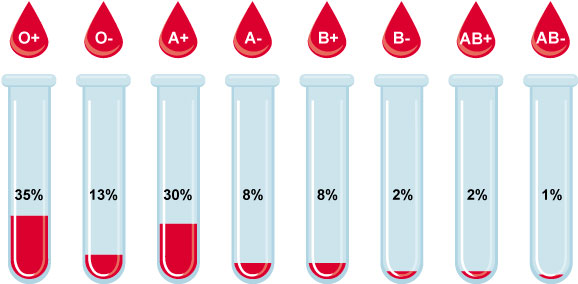5.1 The prosecutor’s fallacy
Judges and juries that are not comfortable with numbers may be at risk of misinterpreting them. A stark example of this is the so-called ‘prosecutor’s fallacy’. This is where the probability of a particular scientific test is mistakenly assumed to be the same as the probability of guilt.
Because the prosecutor’s fallacy is quite a tricky idea to understand, the following activity will guide you through the idea in a series of small steps.
Activity 5 The prosecutor’s fallacy
Read through the following scenario and answer the questions as you progress.
Part 1
Imagine a scenario in which a burglary has been committed. Blood recovered from the scene of the burglary is type AB−, which is possessed by one person in a hundred or 1% of the population of the UK (see Figure 14 for the distribution of blood types in the UK).
Josip has been arrested. He was in the area where the burglary was committed at the time it was committed and has blood type AB−.
If this is the only evidence, what would you estimate the probability that Josip committed the burglary is? Once you have made your selection, remember to click ‘Save response’. Once you have saved your response, you can compare your view with that of other learners taking this course. The results of the poll are displayed by clicking the discussion tab below.
Comment
The results of the poll are displayed below. You may need to refresh your browser to load the results.
a.
More than 99%
b.
99%
c.
Less than 99%
d.
Difficult to say
The correct answer is c.
Discussion
You may have been tempted for the poll at the outset to choose 99%, but that would have been to ignore how many people could have committed the crime, a number sometimes called the ‘base rate’. The correct answer at that stage would have been ‘difficult to say’, as you were not given the base rate. Given the further information that 10,000 people had the opportunity and one person in a hundred has this blood type, then statistically, it is likely that there would be 100 from this group who test positive (this is calculated by dividing 10,000 by 100). The probability of Josip being involved is, therefore, only 1 in 100, 1%, or 0.01. Without the base rate information, it is difficult to say how likely it was that they committed the crime. Only with the base rate information can you give a figure.
In summary, this activity should have demonstrated that the prosecutor’s fallacy (the idea that the probability of a positive test is the same as the probability of guilt) is often unsafe. There are a lot of other pieces of information, and assumptions, that you need to be aware of before you can make any assessment of guilt.
Do not feel bad if you did fall for the prosecutor’s fallacy. It even happens to experts who should know better. In R v Deen,Footnote 29 the Court of Appeal quashed a conviction in a rape case for precisely this reason. The DNA expert had said the probability of a positive test was 1 in 3 million and then made the mistake of concluding that the likelihood of the DNA coming from anybody other than Andrew Deen was also 1 in 3 million, a mistake that was adopted by the judge in the summing up to the jury. A retrial was ordered (at which he was convicted again, but this time not based upon a mathematical error).
Footnotes
- 29 Times, January 10, 1994.Back to main text

